2011 KIA Soul tow
[x] Cancel search: towPage 277 of 356
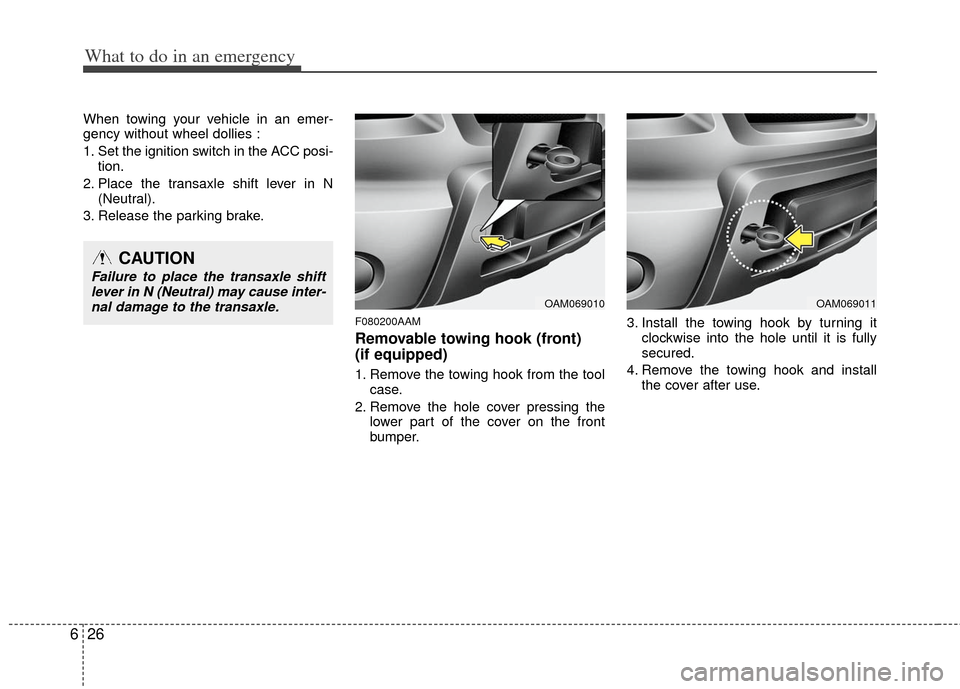
What to do in an emergency
26
6
When towing your vehicle in an emer-
gency without wheel dollies :
1. Set the ignition switch in the ACC posi-
tion.
2. Place the transaxle shift lever in N (Neutral).
3. Release the parking brake.
F080200AAM
Removable towing hook (front)
(if equipped)
1. Remove the towing hook from the tool case.
2. Remove the hole cover pressing the lower part of the cover on the front
bumper. 3. Install the towing hook by turning it
clockwise into the hole until it is fully
secured.
4. Remove the towing hook and install the cover after use.
CAUTION
Failure to place the transaxle shiftlever in N (Neutral) may cause inter-nal damage to the transaxle.
OAM069010OAM069011
Page 278 of 356
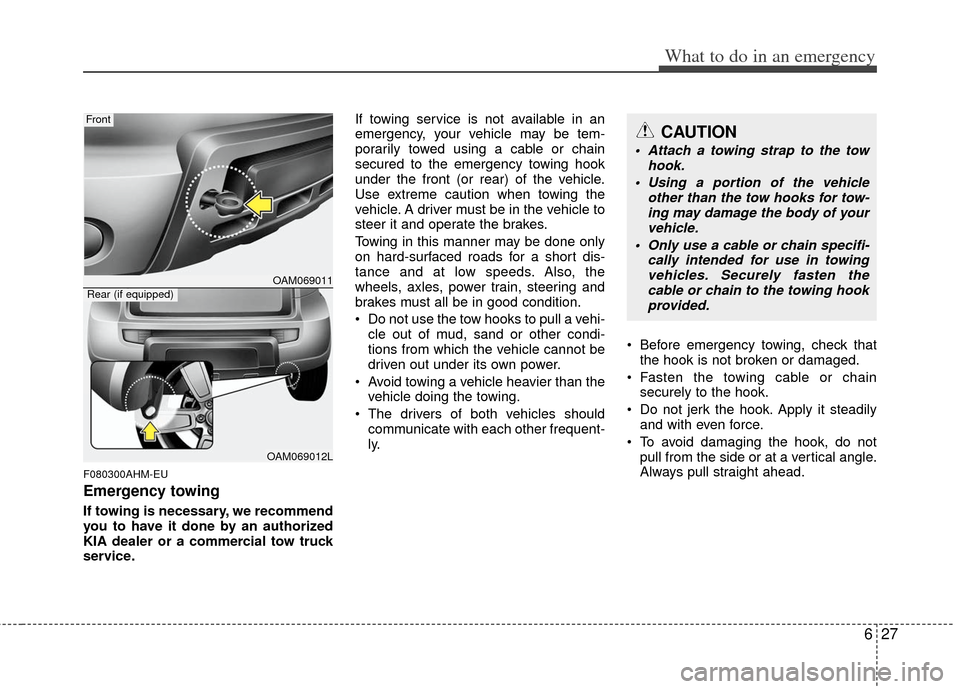
627
What to do in an emergency
F080300AHM-EU
Emergency towing
If towing is necessary, we recommend
you to have it done by an authorized
KIA dealer or a commercial tow truck
service.If towing service is not available in an
emergency, your vehicle may be tem-
porarily towed using a cable or chain
secured to the emergency towing hook
under the front (or rear) of the vehicle.
Use extreme caution when towing the
vehicle. A driver must be in the vehicle to
steer it and operate the brakes.
Towing in this manner may be done only
on hard-surfaced roads for a short dis-
tance and at low speeds. Also, the
wheels, axles, power train, steering and
brakes must all be in good condition.
Do not use the tow hooks to pull a vehi-
cle out of mud, sand or other condi-
tions from which the vehicle cannot be
driven out under its own power.
Avoid towing a vehicle heavier than the vehicle doing the towing.
The drivers of both vehicles should communicate with each other frequent-
ly. Before emergency towing, check that
the hook is not broken or damaged.
Fasten the towing cable or chain securely to the hook.
Do not jerk the hook. Apply it steadily and with even force.
To avoid damaging the hook, do not pull from the side or at a vertical angle.
Always pull straight ahead.
CAUTION
Attach a towing strap to the tow hook.
Using a portion of the vehicle other than the tow hooks for tow-ing may damage the body of yourvehicle.
Only use a cable or chain specifi- cally intended for use in towingvehicles. Securely fasten thecable or chain to the towing hookprovided.
OAM069011
OAM069012L
Front
Rear (if equipped)
Page 279 of 356
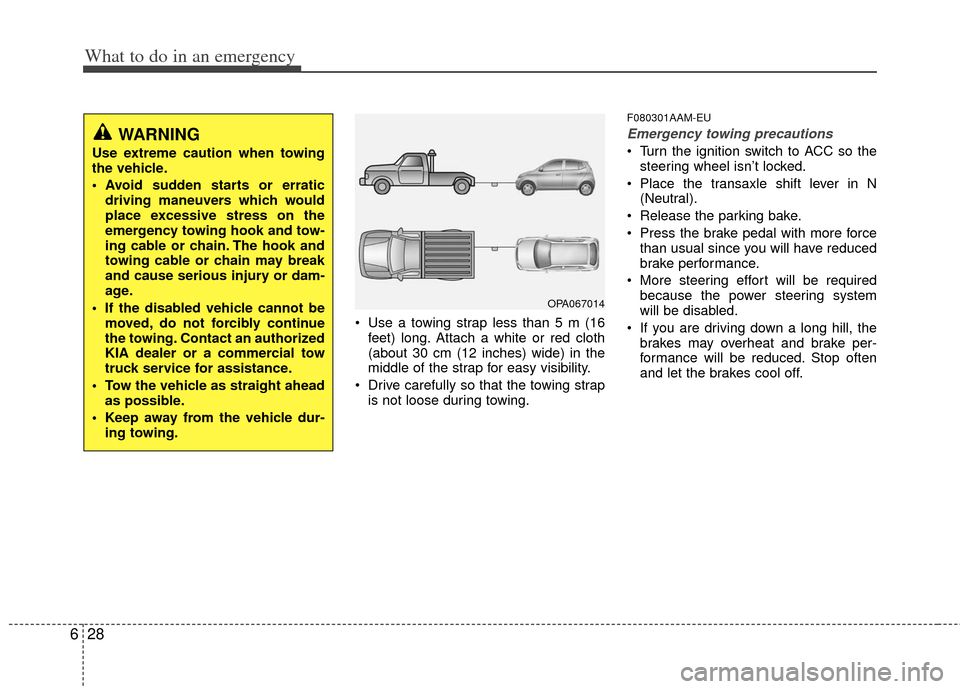
What to do in an emergency
28
6
Use a towing strap less than 5 m (16
feet) long. Attach a white or red cloth
(about 30 cm (12 inches) wide) in the
middle of the strap for easy visibility.
Drive carefully so that the towing strap is not loose during towing.
F080301AAM-EU
Emergency towing precautions
Turn the ignition switch to ACC so thesteering wheel isn’t locked.
Place the transaxle shift lever in N (Neutral).
Release the parking bake.
Press the brake pedal with more force than usual since you will have reduced
brake performance.
More steering effort will be required because the power steering system
will be disabled.
If you are driving down a long hill, the brakes may overheat and brake per-
formance will be reduced. Stop often
and let the brakes cool off.
WARNING
Use extreme caution when towing
the vehicle.
driving maneuvers which would
place excessive stress on the
emergency towing hook and tow-
ing cable or chain. The hook and
towing cable or chain may break
and cause serious injury or dam-
age.
If the disabled vehicle cannot be moved, do not forcibly continue
the towing. Contact an authorized
KIA dealer or a commercial tow
truck service for assistance.
Tow the vehicle as straight ahead as possible.
Keep away from the vehicle dur- ing towing.
OPA067014
Page 280 of 356
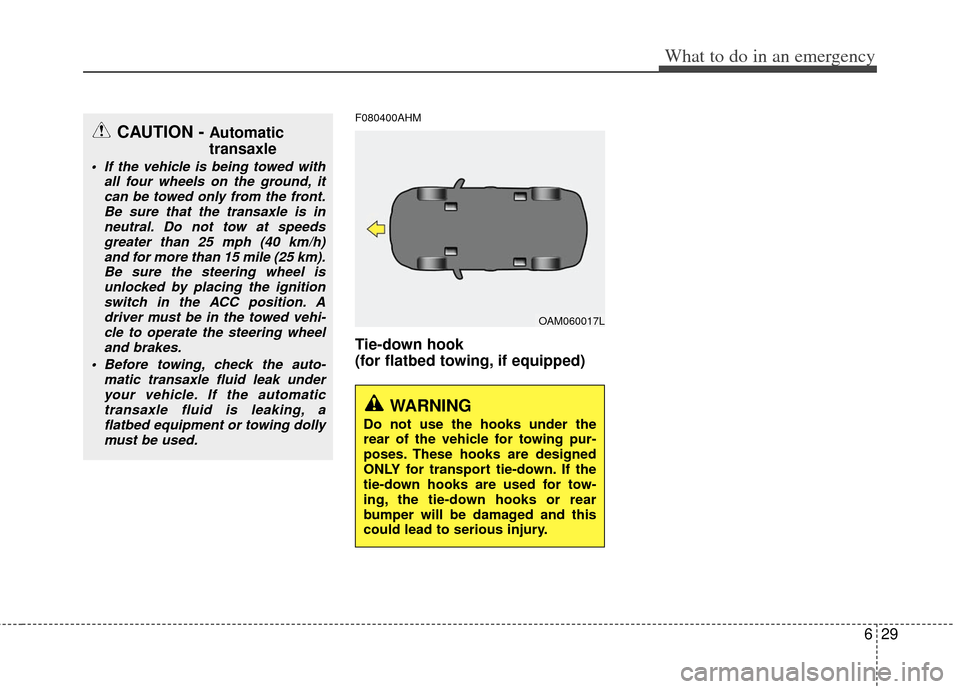
629
What to do in an emergency
F080400AHM
Tie-down hook
(for flatbed towing, if equipped)
WARNING
Do not use the hooks under the
rear of the vehicle for towing pur-
poses. These hooks are designed
ONLY for transport tie-down. If the
tie-down hooks are used for tow-
ing, the tie-down hooks or rear
bumper will be damaged and this
could lead to serious injury.
CAUTION - Automatic
transaxle
If the vehicle is being towed with
all four wheels on the ground, itcan be towed only from the front.Be sure that the transaxle is inneutral. Do not tow at speeds greater than 25 mph (40 km/h)and for more than 15 mile (25 km).Be sure the steering wheel isunlocked by placing the ignitionswitch in the ACC position. Adriver must be in the towed vehi-cle to operate the steering wheeland brakes.
Before towing, check the auto- matic transaxle fluid leak underyour vehicle. If the automatictransaxle fluid is leaking, aflatbed equipment or towing dollymust be used.
OAM060017L
Page 295 of 356
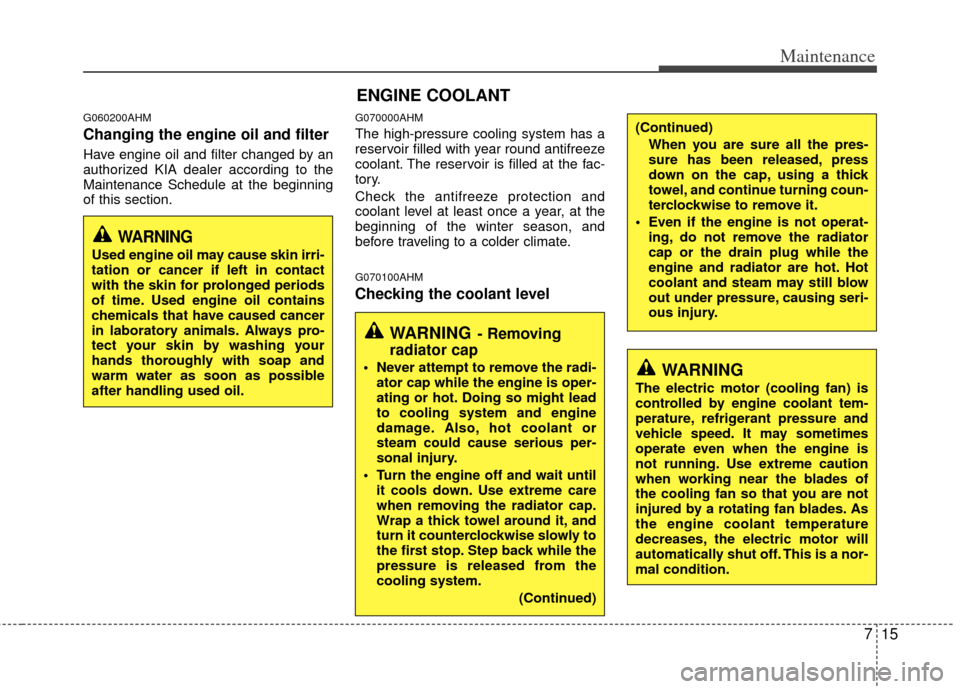
715
Maintenance
G060200AHM
Changing the engine oil and filter
Have engine oil and filter changed by an
authorized KIA dealer according to the
Maintenance Schedule at the beginning
of this section.
G070000AHM
The high-pressure cooling system has a
reservoir filled with year round antifreeze
coolant. The reservoir is filled at the fac-
tory.
Check the antifreeze protection and
coolant level at least once a year, at the
beginning of the winter season, and
before traveling to a colder climate.
G070100AHM
Checking the coolant level
ENGINE COOLANT
WARNING- Removing
radiator cap
Never attempt to remove the radi-
ator cap while the engine is oper-
ating or hot. Doing so might lead
to cooling system and engine
damage. Also, hot coolant or
steam could cause serious per-
sonal injury.
Turn the engine off and wait until it cools down. Use extreme care
when removing the radiator cap.
Wrap a thick towel around it, and
turn it counterclockwise slowly to
the first stop. Step back while the
pressure is released from the
cooling system.
(Continued)
(Continued)When you are sure all the pres-
sure has been released, press
down on the cap, using a thick
towel, and continue turning coun-
terclockwise to remove it.
Even if the engine is not operat- ing, do not remove the radiator
cap or the drain plug while the
engine and radiator are hot. Hot
coolant and steam may still blow
out under pressure, causing seri-
ous injury.
WARNING
Used engine oil may cause skin irri-
tation or cancer if left in contact
with the skin for prolonged periods
of time. Used engine oil contains
chemicals that have caused cancer
in laboratory animals. Always pro-
tect your skin by washing your
hands thoroughly with soap and
warm water as soon as possible
after handling used oil.
WARNING
The electric motor (cooling fan) is
controlled by engine coolant tem-
perature, refrigerant pressure and
vehicle speed. It may sometimes
operate even when the engine is
not running. Use extreme caution
when working near the blades of
the cooling fan so that you are not
injured by a rotating fan blades. As
the engine coolant temperature
decreases, the electric motor will
automatically shut off. This is a nor-
mal condition.
Page 350 of 356

I3
Index
Child restraint system ··················\
··················\
················3-25Auto lock mode (Passenger seat belt) ··················\
·····3-28
Lower anchor system ··················\
··················\
············3-31
Tether anchor system··················\
··················\
·············3-30
Child-protector rear door lock ··················\
··················\
···4-16
Climate control system (Automatic) ··················\
···········4-77 Air conditioning ··················\
··················\
··················\
··4-83
Automatic heating and air conditioning··················\
··4-78
Manual heating and air conditioning ··················\
······4-69
Climate control system (Manual) ··················\
···············4-68 Air conditioning ··················\
··················\
··················\
··4-73
Heating and air conditioning··················\
··················\
·4-69
Climate control air filter ··················\
··················\
············4-75
Combined instrument, see instrument cluster ···············4-37
Compact spare tire ··················\
··················\
··················\
···6-23
Compact spare tire replacement ··················\
··················\
7-35
Coolant ··················\
··················\
··················\
··················\
···7-15
Cooling fluid, see engine coolant ··················\
················7-16
Crankcase emission control system ··················\
·············7-58
Cruise control system ··················\
··················\
················5-32
Cup holder ··················\
··················\
··················\
···············4-90
Curtain air bag ··················\
··················\
··················\
·········3-51
Dashboard, see instrument cluster ··················\
···············4-37
Defogging (Windshield) ··················\
··················\
············4-84
Defogging logic (Windshield) ··················\
··················\
···4-86
Defroster (Rear window) ··················\
··················\
···········4-67 Defrosting (Windshield) ··················\
··················\
············4-84
Dimensions ··················\
··················\
··················\
················8-2
Door locks··················\
··················\
··················\
················4-13
Central door lock switch ··················\
··················\
·······4-15
Child-protector rear door lock ··················\
················4-16
Drinks holders, see cup holders··················\
··················\
·4-90
Driver's air bag··············\
··················\
··················\
·············3-45
Driving at night··················\
··················\
··················\
········5-40
Driving in flooded areas ··················\
··················\
············5-41
Driving in the rain ··················\
··················\
··················\
···5-41
Economical operation ··················\
··················\
················5-36
Electric chromic mirror (ECM) ··················\
··················\
·4-33
Electronic stability control (ESC) ··················\
···············5-27
Emergency starting ··················\
··················\
··················\
····6-4 Jump starting ··················\
··················\
··················\
·········6-4
Push starting ··················\
··················\
··················\
··········6-5
Emergency tailgate safety release··················\
················4-18
Emergency towing ··················\
··················\
··················\
···6-27
Emergency while driving··················\
··················\
·············6-2
Emission control system ··················\
··················\
············7-58 Crankcase emission control system ··················\
········7-58
Evaporative emission control (including ORVR) System ··················\
··················\
··················\
··············7-58
Exhaust emission control system ··················\
············7-59
Engine compartment ··················\
··················\
············2-4, 7-2
Engine coolant ··················\
··················\
··················\
·········7-15
D
E
Page 355 of 356
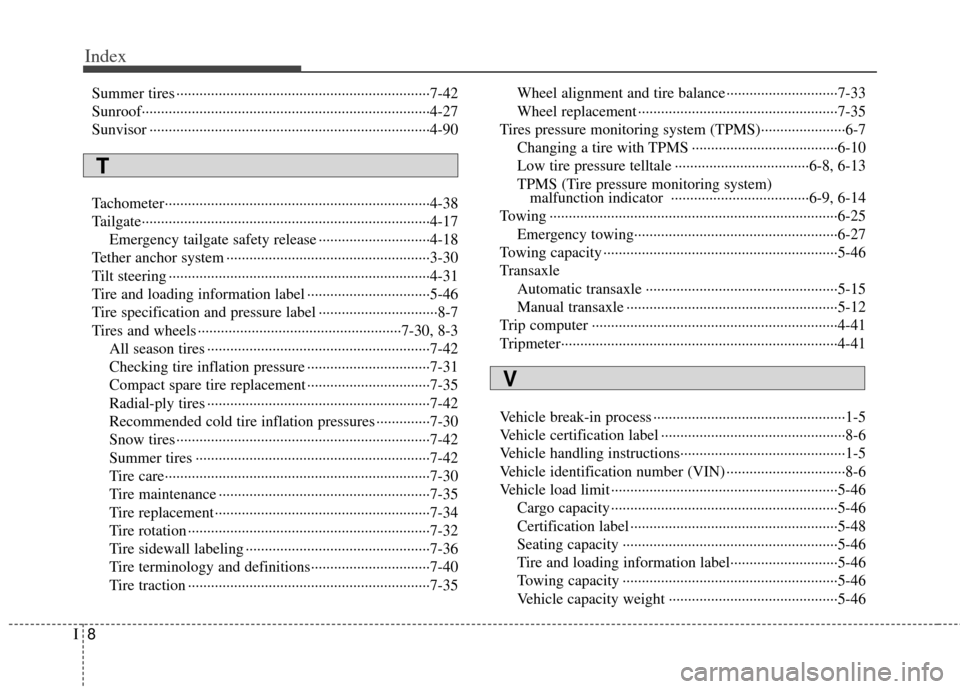
Index
8I
Summer tires ··················\
··················\
··················\
············7-42
Sunroof··················\
··················\
··················\
··················\
···4-27
Sunvisor ··················\
··················\
··················\
··················\
·4-90
Tachometer··················\
··················\
··················\
···············4-38
Tailgate··················\
··················\
··················\
··················\
···4-17Emergency tailgate safety release ··················\
···········4-18
Tether anchor system ··················\
··················\
·················3-30\
Tilt steering ··················\
··················\
··················\
··············4-31
Tire and loading information label ··················\
··············5-46
Tire specification and pressure label ··················\
·············8-7
Tires and wheels ··················\
··················\
·················7-30\
, 8-3 All season tires ··················\
··················\
··················\
····7-42
Checking tire inflation pressure ··················\
··············7-31
Compact spare tire replacement ··················\
··············7-35
Radial-ply tires ··················\
··················\
··················\
····7-42
Recommended cold tire inflation pressures ··············7-30
Snow tires ··················\
··················\
··················\
············7-42
Summer tires ··················\
··················\
··················\
·······7-42
Tire care··················\
··················\
··················\
···············7-30
Tire maintenance ··················\
··················\
··················\
·7-35
Tire replacement ··················\
··················\
··················\
··7-34
Tire rotation ··················\
··················\
··················\
·········7-32
Tire sidewall labeling ··················\
··················\
············7-36
Tire terminology and definitions··················\
·············7-40
Tire traction ··················\
··················\
··················\
·········7-35 Wheel alignment and tire balance ··················\
···········7-33
Wheel replacement ··················\
··················\
················7-35
Tires pressure monitoring system (TPMS)··················\
····6-7 Changing a tire with TPMS ··················\
··················\
··6-10
Low tire pressure telltale ··················\
·················6-8,\
6-13
TPMS (Tire pressure monitoring system) malfunction indicator ··················\
··················\
6-9, 6-14
Towing ··················\
··················\
··················\
··················\
···6-25 Emergency towing··················\
··················\
·················6-27\
Towing capacity ··················\
··················\
··················\
·······5-46
Transaxle Automatic transaxle ··················\
··················\
··············5-15
Manual transaxle ··················\
··················\
··················\
·5-12
Trip computer ··················\
··················\
··················\
··········4-41
Tripmeter··················\
··················\
··················\
··················\
4-41
Vehicle break-in process ··················\
··················\
··············1-5
Vehicle certification label ··················\
··················\
············8-6
Vehicle handling instructions··················\
··················\
·······1-5
Vehicle identification number (VIN) ··················\
·············8-6
Vehicle load limit ··················\
··················\
··················\
·····5-46 Cargo capacity ··················\
··················\
··················\
·····5-46
Certification label ··················\
··················\
··················\
5-48
Seating capacity ··················\
··················\
··················\
··5-46
Tire and loading information label··················\
··········5-46
Towing capacity ··················\
··················\
··················\
··5-46
Vehicle capacity weight ··················\
··················\
········5-46
T
V